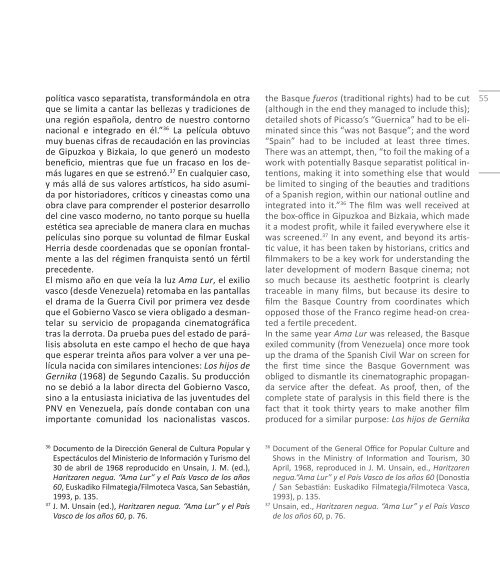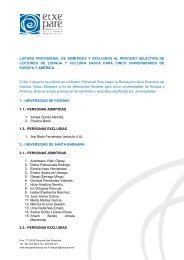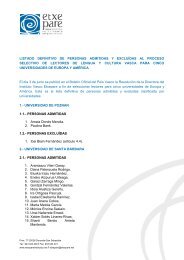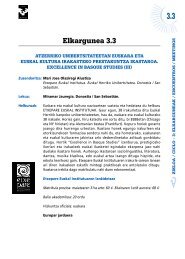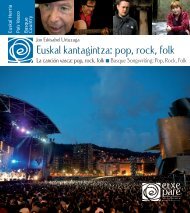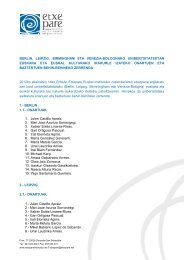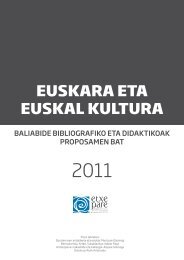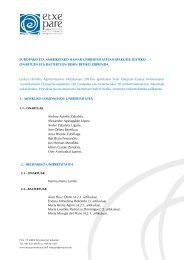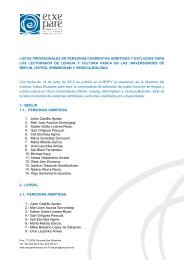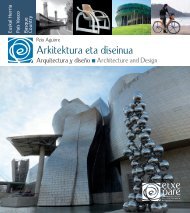Euskal zinema / Cine vasco / Basque Cinema - Etxepare, Euskal ...
Euskal zinema / Cine vasco / Basque Cinema - Etxepare, Euskal ...
Euskal zinema / Cine vasco / Basque Cinema - Etxepare, Euskal ...
- No tags were found...
Create successful ePaper yourself
Turn your PDF publications into a flip-book with our unique Google optimized e-Paper software.
política <strong>vasco</strong> separatista, transformándola en otraque se limita a cantar las bellezas y tradiciones deuna región española, dentro de nuestro contornonacional e integrado en él.” 36 La película obtuvomuy buenas cifras de recaudación en las provinciasde Gipuzkoa y Bizkaia, lo que generó un modestobeneficio, mientras que fue un fracaso en los demáslugares en que se estrenó. 37 En cualquier caso,y más allá de sus valores artísticos, ha sido asumidapor historiadores, críticos y cineastas como unaobra clave para comprender el posterior desarrollodel cine <strong>vasco</strong> moderno, no tanto porque su huellaestética sea apreciable de manera clara en muchaspelículas sino porque su voluntad de filmar <strong>Euskal</strong>Herria desde coordenadas que se oponían frontalmentea las del régimen franquista sentó un fértilprecedente.El mismo año en que veía la luz Ama Lur, el exilio<strong>vasco</strong> (desde Venezuela) retomaba en las pantallasel drama de la Guerra Civil por primera vez desdeque el Gobierno Vasco se viera obligado a desmantelarsu servicio de propaganda cinematográficatras la derrota. Da prueba pues del estado de parálisisabsoluta en este campo el hecho de que hayaque esperar treinta años para volver a ver una películanacida con similares intenciones: Los hijos deGernika (1968) de Segundo Cazalis. Su producciónno se debió a la labor directa del Gobierno Vasco,sino a la entusiasta iniciativa de las juventudes delPNV en Venezuela, país donde contaban con unaimportante comunidad los nacionalistas <strong>vasco</strong>s.the <strong>Basque</strong> fueros (traditional rights) had to be cut(although in the end they managed to include this);detailed shots of Picasso’s “Guernica” had to be eliminatedsince this “was not <strong>Basque</strong>”; and the word“Spain” had to be included at least three times.There was an attempt, then, “to foil the making of awork with potentially <strong>Basque</strong> separatist political intentions,making it into something else that wouldbe limited to singing of the beauties and traditionsof a Spanish region, within our national outline andintegrated into it.” 36 The film was well received atthe box-office in Gipuzkoa and Bizkaia, which madeit a modest profit, while it failed everywhere else itwas screened. 37 In any event, and beyond its artisticvalue, it has been taken by historians, critics andfilmmakers to be a key work for understanding thelater development of modern <strong>Basque</strong> cinema; notso much because its aesthetic footprint is clearlytraceable in many films, but because its desire tofilm the <strong>Basque</strong> Country from coordinates whichopposed those of the Franco regime head-on createda fertile precedent.In the same year Ama Lur was released, the <strong>Basque</strong>exiled community (from Venezuela) once more tookup the drama of the Spanish Civil War on screen forthe first time since the <strong>Basque</strong> Government wasobliged to dismantle its cinematographic propagandaservice after the defeat. As proof, then, of thecomplete state of paralysis in this field there is thefact that it took thirty years to make another filmproduced for a similar purpose: Los hijos de Gernika5536Documento de la Dirección General de Cultura Popular yEspectáculos del Ministerio de Información y Turismo del30 de abril de 1968 reproducido en Unsain, J. M. (ed.),Haritzaren negua. “Ama Lur” y el País Vasco de los años60, Euskadiko Filmategia/Filmoteca Vasca, San Sebastián,1993, p. 135.37J. M. Unsain (ed.), Haritzaren negua. “Ama Lur” y el PaísVasco de los años 60, p. 76.36Document of the General Office for Popular Culture andShows in the Ministry of Information and Tourism, 30April, 1968, reproduced in J. M. Unsain, ed., Haritzarennegua.“Ama Lur” y el País Vasco de los años 60 (Donostia/ San Sebastián: Euskadiko Filmategia/Filmoteca Vasca,1993), p. 135.37Unsain, ed., Haritzaren negua. “Ama Lur” y el País Vascode los años 60, p. 76.


